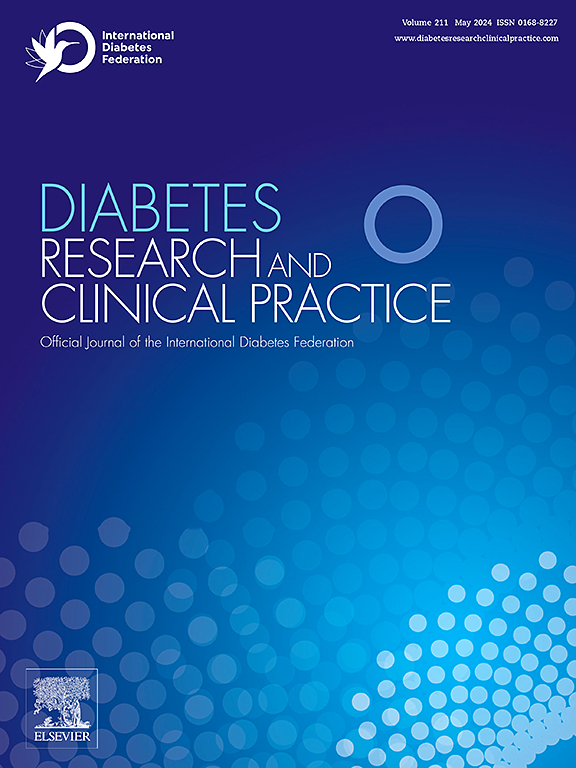新型临床和行为标志物与HbA1c改善的关联:对912例2型糖尿病患者的潜在分类分析
IF 6.1
3区 医学
Q1 ENDOCRINOLOGY & METABOLISM
引用次数: 0
摘要
目的:2型糖尿病(T2DM)的不断上升的患病率压倒了医疗系统。生活方式干预增强患者监测和依从性的效果各不相同,强调需要了解不同患者亚组的差异反应。本研究旨在将T2DM患者划分为不同的潜在类别,并确定与最佳12个月糖化血红蛋白(HbA1c)降低相关的特征。方法:我们前瞻性地从新加坡政府资助的门诊招募了1000例T2DM患者,年龄 ≥ ,40岁,HbA1c ≥ 7.0 %。排除标准包括胰岛素治疗和认知障碍。使用mHealth干预、年龄、教育程度、生活安排、基线HbA1c、步数和动机(患者激活测量)作为指标,对912名患者进行了潜在分类分析。采用单因素方差分析和两两t检验评估12个月HbA1c降低情况。结果:在队列中,受过高等教育、体力活动和基线HbA1c的年轻患者HbA1c改善最大(1.14 ± 1.79 %)。受教育程度较低的年轻患者,尽管基线HbA1c较高,但HbA1c的改善程度较低(0.52 ± 1.41 %)。结论:生活方式干预后,HbA1c基线、教育程度、动机和活动水平较高的个体HbA1c降低最为显著。针对这些可改变的特征量身定制的方法可能有助于患者实现12个月的糖化血红蛋白显著降低。本文章由计算机程序翻译,如有差异,请以英文原文为准。
Association of Novel Clinical and Behavioural Markers with HbA1c Improvement: A Latent Class Analysis of 912 Patients with Type 2 Diabetes Mellitus
Objective
The escalating prevalence of Type 2 Diabetes Mellitus (T2DM) overwhelms healthcare systems. Lifestyle interventions enhancing patient monitoring and adherence vary in efficacy, emphasizing the need to understand differential response across patient subgroups. This study aimed to segment patients with T2DM into distinct latent classes and identify characteristics associated with optimal 12-month glycated haemoglobin (HbA1c) reduction.
Methods
We prospectively recruited 1000 patients with T2DM from government-funded outpatient clinics in Singapore, aged ≥ 40-year-old with HbA1c ≥ 7.0 %. Exclusion criteria included insulin treatment and cognitive impairment. Latent class analysis was applied to 912 patients, using mHealth interventions, age, education, living arrangement, baseline HbA1c, step count, and motivation (Patient Activation Measure) as indicators. 12-Month HbA1c reduction was assessed with one-way ANOVA and pairwise T-test.
Results
Within cohort, younger patients with higher education, physical activity, and baseline HbA1c exhibited the greatest HbA1c improvement (1.14 ± 1.79 %). Younger patients with lower education, despite high baseline HbA1c, exhibited a moderately lower HbA1c improvement (0.52 ± 1.41 %).
Conclusion
Individuals with higher baseline HbA1c, education, motivation, and activity levels experienced the most significant HbA1c reductions in response to lifestyle interventions. A tailored approach to these modifiable characteristics may help patients achieve substantial 12-month HbA1c reductions.
求助全文
通过发布文献求助,成功后即可免费获取论文全文。
去求助
来源期刊

Diabetes research and clinical practice
医学-内分泌学与代谢
CiteScore
10.30
自引率
3.90%
发文量
862
审稿时长
32 days
期刊介绍:
Diabetes Research and Clinical Practice is an international journal for health-care providers and clinically oriented researchers that publishes high-quality original research articles and expert reviews in diabetes and related areas. The role of the journal is to provide a venue for dissemination of knowledge and discussion of topics related to diabetes clinical research and patient care. Topics of focus include translational science, genetics, immunology, nutrition, psychosocial research, epidemiology, prevention, socio-economic research, complications, new treatments, technologies and therapy.
 求助内容:
求助内容: 应助结果提醒方式:
应助结果提醒方式:


